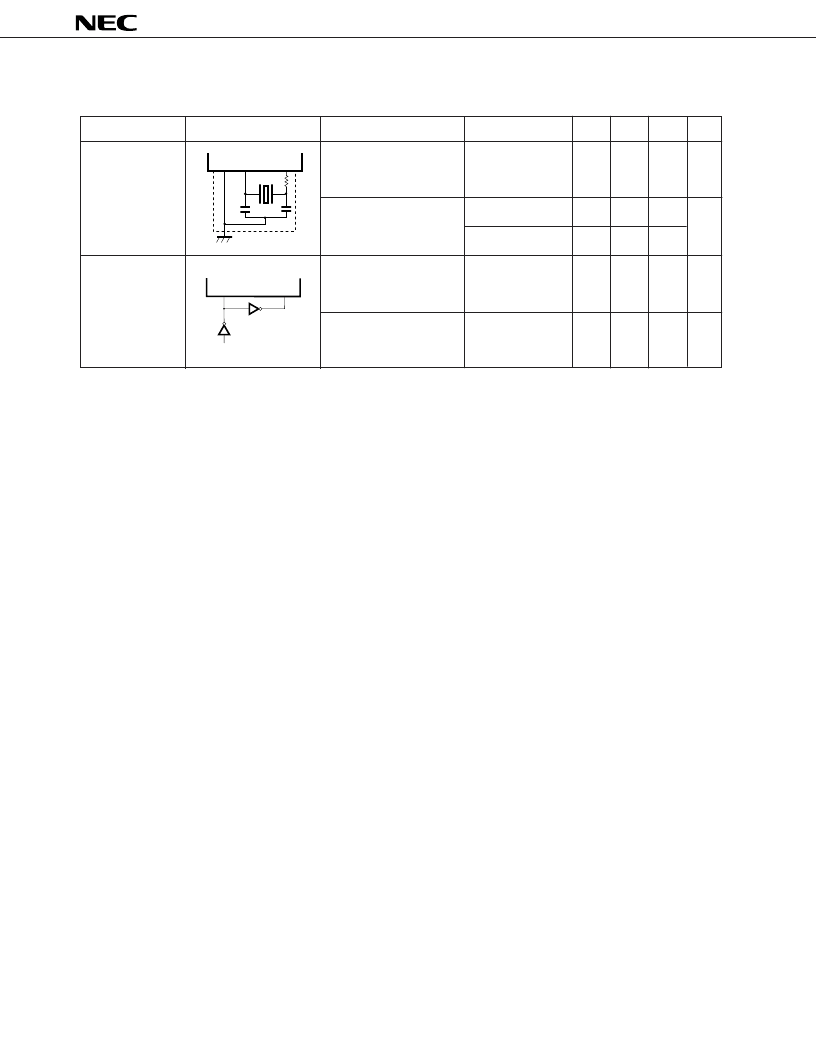- 您現在的位置:買賣IC網 > PDF目錄382787 > μPD780306 (NEC Corp.) 8 Bit Single Chip Microcontrollers(8位單片微控制器) PDF資料下載
參數資料
| 型號: | μPD780306 |
| 廠商: | NEC Corp. |
| 英文描述: | 8 Bit Single Chip Microcontrollers(8位單片微控制器) |
| 中文描述: | 8位單片機微控制器(8位單片微控制器) |
| 文件頁數: | 39/70頁 |
| 文件大?。?/td> | 525K |
| 代理商: | ΜPD780306 |
第1頁第2頁第3頁第4頁第5頁第6頁第7頁第8頁第9頁第10頁第11頁第12頁第13頁第14頁第15頁第16頁第17頁第18頁第19頁第20頁第21頁第22頁第23頁第24頁第25頁第26頁第27頁第28頁第29頁第30頁第31頁第32頁第33頁第34頁第35頁第36頁第37頁第38頁當前第39頁第40頁第41頁第42頁第43頁第44頁第45頁第46頁第47頁第48頁第49頁第50頁第51頁第52頁第53頁第54頁第55頁第56頁第57頁第58頁第59頁第60頁第61頁第62頁第63頁第64頁第65頁第66頁第67頁第68頁第69頁第70頁

39
μ
PD780306, 780308
XT1
XT2
SUBSYSTEM CLOCK OSCILLATOR CHARACTERISTICS (T
A
= –40 to +85
°
C, V
DD
= 2.0
Note 4
to 5.5 V)
Notes 1.
Indicates only oscillation circuit characteristics. Refer to
AC Characteristics
for instruction execution time.
2.
Time required to stabilize oscillation after V
DD
has reached the minimum oscillation voltage range.
3.
After V
DD
reaches the minimum oscillator voltage range.
4.
Actually, oscillation start voltage or over, and V
DD
= 2.0 or over (For an external clock, V
DD
= 2.0 or over is
OK).
Cautions
1.
When using the subsystem clock oscillator, wiring in the area enclosed with the broken line should
be carried out as follows to avoid an adverse effect from wiring capacitance.
Wiring should be as short as possible.
Wiring should not cross other signal lines.
Wiring should not be placed close to a varying high current.
The potential of the oscillator capacitor ground should be the same as V
SS
.
Do not ground it to the ground pattern in which a high current flows.
Do not fetch a signal from the oscillator.
2.
The subsystem clock oscillation circuit is designed as a low amplification circuit to provide low
consumption current, causing misoperation to noise more frequently than the main system clock
oscillation circuit. Special care should therefore be taken to wiring method when the subsystem
clock is used.
V
DD
= 4.5 to 5.5 V
Note 3
Note 3
Crystal resonator
External clock
Oscillator frequency
(f
XT
)
Note 1
Oscillation stabilization
time
Note 2
XT1 input frequency
(f
XT
)
Note 1
XT1 input high-/low-level
width (t
XTH
/t
XTL
)
35
2
10
100
15
32.768
1.2
32
32
5
kHz
s
kHz
μ
s
Resonator
Recommended Circuit
Parameter
Test Conditions
MIN.
TYP.
MAX.
Unit
V
DD
= Oscillator
voltage range
R2
XT2
XT1
IC
C4
C3
相關PDF資料 |
PDF描述 |
|---|---|
| μPD78042F | 8 Bit Single Chip Microcontrollers(8位單片微控制器) |
| μPD78P0018Y | 8 Bit Single Chip Microcontrollers |
| μPD78P014B | 8 Bit Single Chip Microcontrollers |
| μPD78P014BY | 8 Bit Single Chip Microcontrollers |
| μPD78096 | 8 Bit Single Chip Microcontrollers(8位單片微控制器) |
相關代理商/技術參數 |
參數描述 |
|---|---|
| PD780308 | 制造商:NEC 制造商全稱:NEC 功能描述:8-BIT SINGLE-CHIP MICROCOMPUTER |
| PD780336GC-XXX-9EV | 制造商:未知廠家 制造商全稱:未知廠家 功能描述:Microcontroller |
| PD7-80-70A | 制造商:MERRIMAC 制造商全稱:MERRIMAC 功能描述:0 , 75 ohm POWER DIVIDERS / COMBINERS |
| PD784054GCA2 | 制造商:NEC 制造商全稱:NEC 功能描述:16-BIT SINGLE-CHIP MICROCONTROLLER |
| PD784976A | 制造商:NEC 制造商全稱:NEC 功能描述:16-Bit Single-Chip Microcontroller |
發(fā)布緊急采購,3分鐘左右您將得到回復。